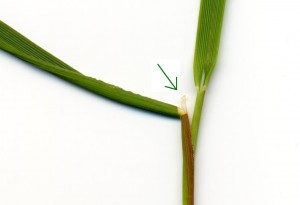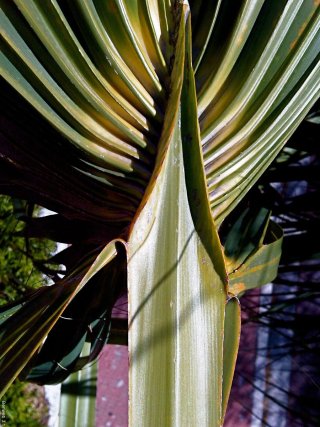In writing the post on hastula, I found out that a hastula is like a ligule. Which I guess is fine, as far as that goes, but really, it doesn’t go very far with me. I, after all, am neither agrostologist nor graminologist, so I had no idea what a ligule might be. According to MW, ligule, or tongue, is from New Latin ligula, from Latin for small tongue or strap, fr. lingere, to lick. They define it as “a thin appendage of a foliage leaf and esp. of the sheath of a blade of grass.”
By coincidence, I just happened to have Walter Kingsley Taylor’s Guide to Florida Grasses checked out of the library (yet another lovely field guide that this father of a 2-year-old hasn’t been able to afford yet), so I was able to dig a little deeper. It’s always good to review the specialized literature when you’re dealing with an unfamiliar technical term. Dr. Taylor tells us that a ligule is a structure that appears
inside the leaf, on the side facing the stem and at or near the blade-sheath-junction.
[The ligule is] an appendage that consists of hairs, a membrane, or a combination of the two. The ligule apparently keeps debris and water from getting between the sheath and stem. The ligule’s length, condition of hairs, and texture of the membrane (leathery, papery, thin) varies with the species. Most grasses have ligules of about one millimeter or less in length, which require magnification to see. In some grass species, notably barnyardgrasses (Echinocloa), the ligule is lacking. Nongrass rushes also lack a ligule, but sedges have them. Bamboos have two membranous ligules: inner and outer.
Here is a picture from Wikipedia of the ligule:

So it looks like Read and Hickey were right—the hastula, being a membranous structure that appears at the leafstalk tip where the segments of a palmate or costapalmate palm leaf join, is somewhat like a ligule. On the other hand, it’s a lot NOT like a ligule. For one thing, a ligule is tiny, usually requiring magnification to see, whereas a hastula is quite a bit larger:
For another thing, the ligule, it is speculated, helps the grass blade grow by keeping the sheath and the stem free of contaminants; the hastula doesn’t really keep the leafstalk of a palm frond clean. I’m not entirely sure what function the structure plays in the palm leaf.
Moral of story? Analogy only gets you so far. And when the things you’re comparing are anatomical structures of plants, they don’t really take you very far at all. At least, as far as I know.


well, I learned something! since I like anything growing in my yard and I like words–this new-found blog is very entertaining. Today I spent a lot of time watching newly-returned-to-the-yard orioles staking out palm trees–perching on the hastulas of washitonian palms! Now I know what to call that particular structure! (when I blog tonight, I’m posting pictures of said oriole on said hastula)
Really, I enjoyed your blog and will be following closely.
Kay http://arroyocoloradoriverblog.blogspot.com